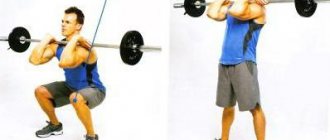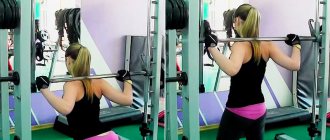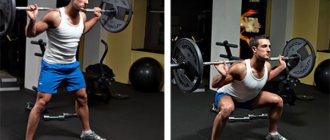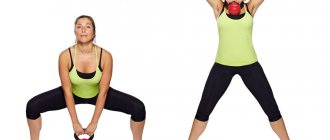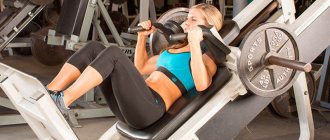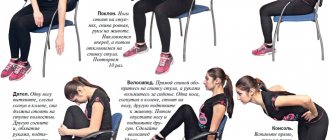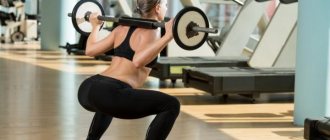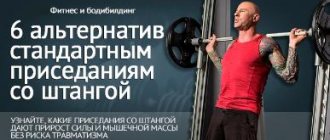How to squat in bodybuilding and powerlifting: differences
To get the maximum results from squats, you need to decide on the main goal of your training. During the first year or two, you just do the standard program, doing squats, for example, on Mondays, and enjoy life. But gradually you begin to notice that you are still tearing your buttocks in the squat, but there is no progress. So it's time to decide what's more important to you: getting stronger or getting bigger.
Of course, strength and mass are related to each other (at least in the case of the squat), but what I mean is that you can squat in different ways, choosing one of two goals. Let's be honest: for a bodybuilder, the weight on the bar does not matter, the main thing is well-developed leg muscles. A powerlifter is still judged by the weight taken, and not by the outstanding volume of the hips. So what's the difference between a builder's squat and a lifter's squat? Let's look at 10 key differences.
1. Number of repetitions
For hypertrophy, an average of 8-12 repetitions works well. However, high-repetition sets (25-50) also help gain muscle volume. And that's why:
- Different ratios of muscle fiber types in the legs. Since people have different ratios of fast-twitch and slow-twitch fibers, those whose legs do not grow from the average rep range can gain mass by longer sets in terms of time and number of repetitions. In general, bodybuilders do all variations - 5 -10 - 25 - 50 repetitions in order to stimulate all fibers to the maximum: some in one workout, others alternating ranges in monthly cycles. ( Therefore, even approaches with a large number of repetitions (25-50) can add mass if you do not control calories - greetings from Zozhnik to girls who practice high repetitions )
- With a high number of repetitions, more blood is pumped into the legs - a pump never hurts.
- In addition, more growth hormone is produced - it helps with muscle gain and fat loss.
If you look at the programs of powerlifters, weightlifters and other strength athletes, they usually prescribe from 1 to 5 repetitions per set. Five repetitions is a classic canon for developing strength and adding useful muscles. When you want a record without increasing size (you don't want to move into the next category), stay in the 1-3 rep range.
How to do squats at home correctly
You should make every effort to ensure that everyone admires your lower body. We have collected for you several simple but basic exercises, without which it is almost impossible to pump up your buttocks. Today you will learn how to do squats correctly. Buy sportswear and comfortable sneakers, and feel free to go to the gym.
If today you do not have extra money, then you can start practicing at home. The mechanism for performing standard squats is quite simple. You will be required to place your feet shoulder-width apart and place your hands behind your head. This is the starting position. Always do it correctly and then you will reduce the likelihood of injury. Girls often chase results and damage one of their lower limbs. This happens because they do not get into the starting position correctly and do the squats incorrectly. This threatens torn ligaments and injuries. Another question that worries girls is how many squats to do.
We do not recommend that you start with a large number of approaches or repetitions. The next day you may simply not straighten up. Start by creating a training schedule with gradually increasing the number of repetitions and approaches. The key word here is gradual.
to contents ^
2. Working weight
Bodybuilders, frankly, don’t care how much you weigh as long as your legs grow. Of course, everyone wants to lift more, but to hypertrophy a muscle group you need to direct the load to it. Therefore, you take the weight so that you can do all the planned repetitions with the correct technique. It matters more how you lift, not how much. Slow execution at a 3-1-X-1 tempo (not yet clear, but see next point) stimulates muscle growth even without half a ton on the bar.
In powerlifting, it's exactly the opposite. You don't think about isolating a muscle for hypertrophy. You need to go down to an acceptable depth and get back up - with maximum weight.
3. Pace of execution
Another factor influencing the results is the speed of movement. For example, you see this indication: 4-1-X-1. The first number indicates the eccentric, or negative, phase (lowering of the projectile), that is, the downward movement lasts 4 seconds. The second number is a pause at the bottom point. The next symbol describes the concentric phase (rise), the "X" is used to indicate the maximum possible speed. And the last number is a pause at the top point. If you want more muscles, then at this second contract them further; if your goal is strength, then just take a breath. A few additional comments on each phase.
Eccentric phase It is very important for bodybuilders because... significantly stimulates muscle growth. However, for strength athletes, the negative phase can be too “negative” - it can lead to an increase in post-workout pain. This is not a problem if you squat in a bodybuilding program once a week. But for strength athletes who need to train squats 2-4 times a week, constant soreness clearly does not help.
Pause at the lowest point It can be useful for everyone. Bodybuilders use it to fully stretch working muscles and increase range of motion. Powerlifters linger there to strengthen the movement from the bottom point, eliminating the rebound.
Concentric Phase In powerlifting, you only need one speed - maximum speed. Of course, when you have a couple of hundredweight on your shoulders, the movement will not look too fast, but you should try to rise faster. Slowing down the concentric or eccentric phase is not as beneficial in powerlifting as it is in bodybuilding.
Pause at the top As I said, bodybuilders should contract their muscles at the top. It helps with hypertrophy and improves neuromuscular communication (brain-muscle connection). It is better for powerlifters to simply rest, saving their strength for high-quality performance of the next repetition.
SQUATS - AN ETERNAL TOPIC
Language / Language: ENG RUS
Even though weightlifting consists of two exercises: the snatch and the clean and jerk, many weightlifters and CrossFitters are convinced that getting crazy results in the squat will help them improve their performance in the snatch and clean and jerk. I won’t argue with this opinion, maybe I also don’t know or don’t understand something about training. In this article I will share my personal experience, as well as some scientific research data.
Between 2010 and 2011, I suffered a knee injury that completely changed my Olympic training program and my approach to squats. I actually had to remove all squat loads 8 months before the Olympics because otherwise my knee would pop up and I couldn't train at all. Instead, I focused on the snatch and clean and jerk technique and hoped for a miracle.
My coach Valery Nikulin always said that “strong legs and large kilograms in squats themselves are neither good nor bad, it is important to be able to apply this force to the barbell during the snatch and clean and jerk.” The most in my life I squatted with a barbell on my shoulders was 290 kg for 3 times, and that was still at the age of 21. For a weightlifter, it is important not only how much, but how he squats: technique, angles, dynamics, range of motion.
Over the course of more than 120 years of history, the Soviet school of weightlifting has accumulated a large number of methods for developing leg strength: some methods have proven their worth, others have long been forgotten, and then were remembered again and began to be successfully used in powerlifting.
Indeed, in order to properly train your legs for effective work in weightlifting, squats with a barbell on your shoulders alone are not enough - you need to use many different exercises and methods. You can get acquainted with the intricacies of the method of developing leg strength in my LEGS STRENGTH
.
A question that I am often asked is: at what speed should I squat and what tempo of movements should I use during one approach? Before I share my perspective, let's look at the science. The largest number of experiments on this issue were carried out by Soviet trainers and scientists in the period 1954-1974, but it was never possible to come to a common opinion: the recommendations and training practices of those times actually talk about the effectiveness of using fast, medium and slow squat speeds. Also, there are practically no experimental studies that compare fast, medium and slow squat speeds and the increase in results in the snatch and clean and jerk. One small study from 1976 (SI Lelikov, NN Saxanov), which involved 32 weightlifters (divided into 4 groups), who performed 80% squat load for 5 weeks, 5 sets of 3 times in fast, medium, slow and very slow pace. The most effective increase in results was shown by the group working at an average pace (20.65%), the remaining groups progressed by an average of 12-14% and no statistical difference was recorded between them. At the same time, it was not possible to statistically record differences in energy consumption when performing squats at different speeds.
In my opinion, these data are quite logical. As for the use of various variations of squats (on the bench, with narrow legs, with a pause, with deceleration down and acceleration up, with pre-fatigue), they are quite acceptable at the first stage of the preparatory period, as well as when the athlete seeks to increase body weight
and adapts his training program to this goal.
During the competitive period, most athletes perform mainly only squats with a barbell on the shoulders and on the chest, most often 1-2 times. At the same time, some schools release the load in squats 2-3 weeks before the competition, while others can squat with huge weights (110-120% of the clean and jerk) 2-4 days before entering the platform.
My tips for performing front and back squats:
- Always squat facing the racks - this is a safety issue.
- Don't be afraid to ask for insurance.
- Remove the barbell from the racks correctly and take the correct starting position - always hold the barbell with a full grip.
- Always work through the full range of motion - your ligaments and joints must be prepared for the barbell to plant you deep in competition.
- Patience and correct angles on the downstroke will help you generate maximum power on the upstroke.
- When rising from a low squat, there should be no “dead spots” - one continuous upward movement. If you have a sticking point in your squats, lower your weights and practice a continuous upward movement.
- In your mind, you should always strive to push your pelvis back, knees to the sides and move upward with acceleration - this will help develop muscle forces more effectively.
- Remember, in weightlifting, it doesn’t matter how much you can squat, it’s how much you can lift in the snatch and clean and jerk in competition.
TRAIN TOGETHER – TRAIN RIGHT
4. Time under load
This is the period during which the muscles directly work. Extending the concentric or eccentric phase significantly increases it. Leg muscles are made up of different types of fibers, so they can grow from short and long sets. Even hellish sets of 50 repetitions help with mass growth. Consider a set of 8 reps with a 4-1-4-1 tempo:
- 4 seconds lowering
- 1 second at bottom
- 4 seconds rise
- 1 second at top
So one rep lasts about 10 seconds, and the entire set (i.e. time under tension) lasts 80 seconds, which is great for hypertrophy.
In powerlifting, where only 1RM is important, the sets are very short, the time under load is minimal. Most strength programs call for sets of 5, 3, and 1 reps. Accented negatives (slowing down the eccentric phase) also have benefits for strength development, but most training sets are still performed quickly. This is necessary to reduce post-workout pain and learn to accelerate in the lift. The faster you move the projectile, the stronger you are.
results
At first, it was very difficult for the athletes to get used to such a large load, but after about a month, strength began to increase in both exercises. After about 2 months, the average increase in results in deadlifts and squats was 10% - 15%. And this is a lot for such a period of time.
By the way, for the same person, although one option of deadlift was a priority (classic, on straight legs, or from a stand), the other 2 options were also sometimes included for variety 1-2 times within 2 months.
As I wrote at the beginning of the article, both of these exercises work the same muscles:
- The buttocks work about the same
- The back (back extensors) receives approximately 40% of the load in a squat, and 60% of the load in a deadlift (classic version).
- The front surface of the thigh in a squat receives 60% of the load. And in the deadlift (classic version) - 40% of the load.
That is, the calculation was that in a squat the legs are loaded more, and in the deadlift the back is loaded. And as a result, all major muscle groups receive a heavy load. And this calculation worked.
5. Neck position
In the back squat, the bar can be positioned higher or lower. In its lowest position it is located near the shoulder blades, in its highest position it is on the upper part of the trapezius.
Typically bodybuilders squat with a high bar position because it places the center of gravity over the hips.
Powerlifters do different variations of the squat, but the vast majority prefer a low bar position to shorten the range of motion and transfer the load to the entire pelvic girdle, not just the quads.
Kinds
To lose weight, you need to start with a classic exercise, the technique of which is described above. But if you regularly exercise and want to remove fat folds from a specific place in your body, you can always create your own set of different types of squats.
Classic
Described above. Used to slim down legs/thighs and burn calories. The effect will be faster with a set of exercises.
Plie
This exercise is good for the inner thigh. Differences from the classics: hands are on the belt, and legs are widely spaced. The rest of the technique is the same: look forward, breathe correctly, back straight.
Prison
It is performed using the plie technique, but the hands should be clasped at the back of the head.
Curtsy
Works great on the buttocks and thighs. One leg is placed cross in front of the other. Hands on the belt (if with dumbbells, lowered down). When squatting, you need to bend your legs at an angle of 90 °, moving your pelvis back, lifting your heel off the floor. The back remains straight. The weight is held primarily on the leg that is pointed forward. Go down deeper. Hold for 2 seconds. Rise slowly.
With weights
A beautiful, toned butt is the dream of all women. To make it this way, include squats with a barbell or dumbbells in your complex. They are simply perfect for legs and buttocks. You can do plie, you can do classics. Your hands can also be in different positions: if you have a barbell, hold it exactly at chest level; if you have dumbbells, you can lower them down or hold them in front of you. Increase the load gradually.
Martin
Stand next to a chair, leaning on it with your hands, on one leg. Keep your back straight. Start squatting, while moving your other leg back as far and evenly as possible. Return to starting position. The exercise works great on the inner thigh.
Sumo
The starting position can be any. The main thing is that your hands are between your legs. The ideal option is if they contain dumbbells.
Scissors
Many people wonder if they can benefit from squats to lose weight on their stomach and sides, since these are the most problematic areas for both men and women. To work them out, learn how to perform this exercise (it will be more effective with full training). Legs are straight, arms are extended along the body. Take one leg back so that the second one, standing in front, at this time forms an angle of 90 ° between the thigh and lower leg. Slowly bend your leg (the one at the back), bringing your knee as low as possible to the floor, but without touching it. At the same time, we tear the heel off the floor. Feel how the entire weight of your body lies on the heel of the leg in front. Return to starting position. After you learn how to do the exercise correctly, perform it with additional load in the form of dumbbells or a barbell.
Hindu
Place your feet as wide as possible. In a squat, stand on your toes. Without pausing, quickly rise up, lowering your heels back to the floor. At the same time, you need to perform wave-like movements with your arms and hips. The fast pace of this exercise burns a lot of calories.
If you have sufficient physical fitness, the weight loss complex may also include the following types of squats, the technique of which is more complex:
- lateral;
- plyometric (with jumps);
- on one leg;
- with feet joined together;
- with body rotation;
- with a chair;
- with a gymnastic ball;
- with shock absorber tape;
- with a step;
- near the wall;
- with lunges.
If your goal is solely to lose weight, you can do simple squats with your own weight, without weights. If you also want to pump up your muscles, be sure to lift dumbbells or a barbell. For men, the last option is preferable; these can be squats: Hakk, Zerchera.
6. Body tilt
When you want to work your leg muscles, you try to bend over as little as possible. The closer the body is to a vertical position, the greater the load on the legs. The greater the inclination, the more your back works.
This is why front squats develop the quadriceps so effectively - the body is vertical and the legs work to their full potential. Among lifters, I have seen a variety of options and degrees of inclination, it depends on the individual. The main thing is to lower the pelvis to the desired depth, and everyone chooses the position of the body that is most convenient for themselves.
Reasons to do squats
Every person sets a training goal: to lose weight or do the splits, jump higher or run a marathon. Below is a list of skills that can be achieved by doing squats:
- increasing body weight (pump up muscles),
- reduction of body fat,
- improved coordination,
- development of strength qualities, power, endurance and flexibility,
- improving joint mobility.
More details about each.
Increased muscle volume. This exercise allows you to pump up the muscles of your legs, back and abs. Doing squats stimulates the production of hormones, thereby stimulating muscle growth.
Reduction of body fat. Performing each physical action requires a certain amount of effort, which means energy expenditure. The more muscles involved in the work, the higher the effectiveness of the exercise. This principle can be used to pump up any part of the body. Squats should be included in your workout program to lose weight.
Improved body coordination. Every day people perform movements such as walking and climbing stairs. These simple everyday movements are carried out using muscles, a sense of equilibrium and balance. In the cold season, good coordination helps not to fall on slippery ice, but to stay on your feet if you stumble on the stairs.
Increased strength, endurance, flexibility. By setting goals, everyone strives to achieve them in the shortest possible time. The purpose of training and motivation for it can be: to lose weight for a certain event, increase speed, improve flexibility and jumping ability.
Squats will help you achieve your goals, because it is a universal exercise. It helps to develop any physical quality, pump up your legs and buttocks.
There are several physical qualities of a person:
- force,
- endurance,
- power,
- flexibility,
- speed and strength indicators (jumping ability),
- speed,
- coordination.
Improving joint mobility. The exercise is multi-joint, it involves the hip and knee joints. If you do it every day, joint mobility will improve.
All of these benefits prove that squats should be done. The exercise includes the buttocks, legs and other muscles, develops all physical qualities, helps to lose weight and build muscles.
7. Rest between sets
Bodybuilding uses a variety of intervals, from five minutes of really heavy squats to drop sets with almost no rest. All options are useful for changing the stimulus load that causes new growth. Most often, however, intervals of 1-3 minutes are recommended (depending on the working weight), but there are no strict restrictions.
However, in lifting squats with submaximal weights, rest is critical. It is unlikely that you will be able to squat with 3RM, resting for 30 seconds between sets. Even two minutes is not always enough. At IPF competitions, the minimum pause between attempts is 3 minutes. In workouts where you also squat with a non-empty bar, you can rest 3-10 minutes between sets. Varying your rest time is also helpful, but if you shorten it too much, you will only become more tired, lift less, and end up injuring yourself.
8. Range of motion
In terms of pumping, maximum amplitude is useful for you, so it’s better to learn how to do full squats. Too often we see in the gyms people who do not even go as far as parallel, but are extremely proud of their records. But bending your legs slightly is not a squat.
How deep should you go? As deep as you can without experiencing pain or discomfort. You can add other leg exercises (lunges, hack squats, leg extensions, etc.) to add stress to specific areas, but it's best to build your bodybuilding program on the foundation of the full squat.
But in powerlifting, you only have to go as far as the judges will count you. Sometimes the thigh is almost parallel to the floor, sometimes it is clearly lower. If in training you only sat down to parallel, and the judge wants to see a deeper squat, then you, of course, can go lower, but then you are unlikely to be able to get up.
Of course, in strength training, you may need to squat at different depths to target areas that you find difficult to overcome. If you are weak at the bottom, then do, for example, a squat with a pause at the bottom. If you're struggling in the middle of the movement, you can try heavier partial squats to get stronger in that area.
9. Stand
In a builder squat, the stance is usually shoulder-width apart or slightly wider, with the feet parallel or slightly turned toes out. The goal is to develop quadriceps, not maximal lifting weight.
In lifting, there is often a wider stance (the feet are also slightly turned with their toes outward). This allows you to use more of your pelvic girdle muscles and lift with more weight. But while you may see many powerlifters with a low bar position and a wide stance, this is not the rule for everyone. Your stance should be determined by your body type and hip mobility. Some athletes set records in the squat and narrow stance.
Types of squats that will help you start doing this exercise regularly
It looks like squatting is quite simple, but there is a special squatting technique. In addition, there are types of squats that will help you vary your workouts.
If you need to increase or decrease the intensity of squats, simply change the number of repetitions. This is another advantage of squats - they can be successfully scaled.
1.Basic squat
It's easy to learn the basics of the squat with this initial exercise.
How to do
- In a standing position, legs are placed at shoulder level
- Bend your knees and push your hips back as if you were about to sit in a chair. Raise your arms in front of you so that they are parallel to the floor. Keep your neck neutral and chest lifted.
- Once your thighs are parallel to the floor, pause, then push back through your heels to stand.
Learn more about squat technique
Squat technique: what to do and what not to do
Proper form ensures that you get the most out of every squat.
Do…
- Work your hips
- Sit back with their help
- Engage your core muscles (abdominal and lower back muscles)
No need…
- Allow your knees to bend forward
- Allow the line of the knees to extend beyond the toes
- Push your chest forward
- Hold breath
Squat in step
It may be difficult at first, but over time you will come to love many types of squats.
As soon as you feel light, place a dumbbell in each hand and lower yourself.
Do a step squat:
- Stand with your feet shoulder-width apart. Place your hands on your hips or lower them to your sides.
- Step back and across with your right leg until your left thigh is parallel to the floor. Make sure your chest and chin remain lifted.
- Pause, then push through the heel of your left foot to return to the starting position.
- Repeat the exercise on the other leg to complete 1 repetition.
3.Split squats
This is similar to a forward lunge in that you will be isolating one leg per rep and relying more on your balance.
To do a split squat:
- Get into a forward lunge-like position. Right foot forward. Left leg behind her. The feet are completely flat on the floor.
- Bend your knees so that your back leg almost touches the floor and your thigh is parallel to the floor. Make sure your front leg is bent but your knee doesn't go past your toes.
- Pause, then stand again. Repeat for the desired number of repetitions, then switch legs.
Goblet squats
A well-known form of squatting that is great if you want a challenge in your “squat game” with dumbbells or kettlebells.
To do goblet squats:
- Take a dumbbell (or kettlebell) by one end and wrap your arms around it, allowing the other end to hang toward the floor. Keep your elbows bent.
- Stand with your feet wider than shoulder-width apart and your toes pointing outward.
- Bend your knees and push your hips back. Don't move the dumbbell. Look straight ahead and keep your neck neutral. Your thighs may not be parallel to the floor, but get them as low as you can.
- Pause, then push through your heels to return to the starting position.
5. Squats with a chair
Pull up a chair and you can begin.
To try chair squats:
- Stand with your back to the chair in front of it, feet shoulder-width apart, toes pointing straight ahead.
- Activate your abs, keep your spine neutral. Raise your head and chest.
- Lower your hips down and back as if you were about to sit down in a chair. (Raise your arms in front of you to help maintain balance.)
- Touch your buttocks to the chair, but don't sit down.
- Squeeze your glutes and hamstrings to move your hips forward. Then return to the starting position.
Wall Squat
All you need is a wall to break the spirit of boredom in your squats. This variation is also easier on the knees and hips.
Try wall squats:
- Stand with your back to the wall. Place your feet approximately 25-35 centimeters from the wall, shoulder width apart.
- Bend your knees and squat with your back against the wall until your thighs are parallel to the floor.
- Push through your heels to return to the starting position.
Pistol squat
Need a bigger challenge? Increase the load with this advanced single-leg squat.
If you're already a pro, try holding a dumbbell in each hand or a medicine ball in both hands.
Do a pistol squat:
- Stand on your right leg and extend your left leg, holding it slightly in front of your body. Keep your arms at your sides or in front of you for balance.
- Push your hips back as you lower into the squat position, moving your thighs parallel to the floor.
- Squeeze your glutes and lean on your right leg to return to a standing position.
